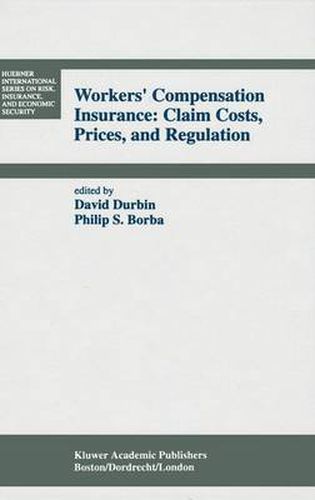Readings Newsletter
Become a Readings Member to make your shopping experience even easier.
Sign in or sign up for free!
You’re not far away from qualifying for FREE standard shipping within Australia
You’ve qualified for FREE standard shipping within Australia
The cart is loading…






This title is printed to order. This book may have been self-published. If so, we cannot guarantee the quality of the content. In the main most books will have gone through the editing process however some may not. We therefore suggest that you be aware of this before ordering this book. If in doubt check either the author or publisher’s details as we are unable to accept any returns unless they are faulty. Please contact us if you have any questions.
The articles in this volume were first presented at the Seventh and Eighth Conferences on Economic Issues in Workers’ Compensation sponsored by the National Council on Compensation Insurance. A principal objective of the Conference series has been for workers’ compensation insurance researchers to apply state-of-the-art research methodologies to policy questions of interest to the workers’ compensation insurance community. This community is a rather diverse group–it includes employers, insurers, injured workers, regulators, and legislators, as well as those who service or represent these groups (e.g., physicians, rehabilitation specialists, labor unions). Despite this diversity and the variety of agendas, the Conference series continues to address many important policy questions. Readers familiar with the Conference series and the four previously published volumes should notice an evolution in terms of the topics addressed in this volume. In the earlier conferences, the topics were more often concerned with the underlying causes of the tremendous increase in workers’ compensation benefit payments. In the present volume, h- ever, only four of the fourteen chapters directly concern workers’ c- pensation insurance benefits, while the other ten concern the pricing of workers compensation insurance. This is not to suggest that workers’ compensation cost increases have abated. In 1989, workers’ compensation incurred losses exceeded $45 billion to continue the annual double-digit cost increases. Two explanations can be offered for the somewhat altered focus of this volume. First, despite the continued increase in prices, the financial results for the workers’ compensation insurance line continue to be poor.
$9.00 standard shipping within Australia
FREE standard shipping within Australia for orders over $100.00
Express & International shipping calculated at checkout
This title is printed to order. This book may have been self-published. If so, we cannot guarantee the quality of the content. In the main most books will have gone through the editing process however some may not. We therefore suggest that you be aware of this before ordering this book. If in doubt check either the author or publisher’s details as we are unable to accept any returns unless they are faulty. Please contact us if you have any questions.
The articles in this volume were first presented at the Seventh and Eighth Conferences on Economic Issues in Workers’ Compensation sponsored by the National Council on Compensation Insurance. A principal objective of the Conference series has been for workers’ compensation insurance researchers to apply state-of-the-art research methodologies to policy questions of interest to the workers’ compensation insurance community. This community is a rather diverse group–it includes employers, insurers, injured workers, regulators, and legislators, as well as those who service or represent these groups (e.g., physicians, rehabilitation specialists, labor unions). Despite this diversity and the variety of agendas, the Conference series continues to address many important policy questions. Readers familiar with the Conference series and the four previously published volumes should notice an evolution in terms of the topics addressed in this volume. In the earlier conferences, the topics were more often concerned with the underlying causes of the tremendous increase in workers’ compensation benefit payments. In the present volume, h- ever, only four of the fourteen chapters directly concern workers’ c- pensation insurance benefits, while the other ten concern the pricing of workers compensation insurance. This is not to suggest that workers’ compensation cost increases have abated. In 1989, workers’ compensation incurred losses exceeded $45 billion to continue the annual double-digit cost increases. Two explanations can be offered for the somewhat altered focus of this volume. First, despite the continued increase in prices, the financial results for the workers’ compensation insurance line continue to be poor.